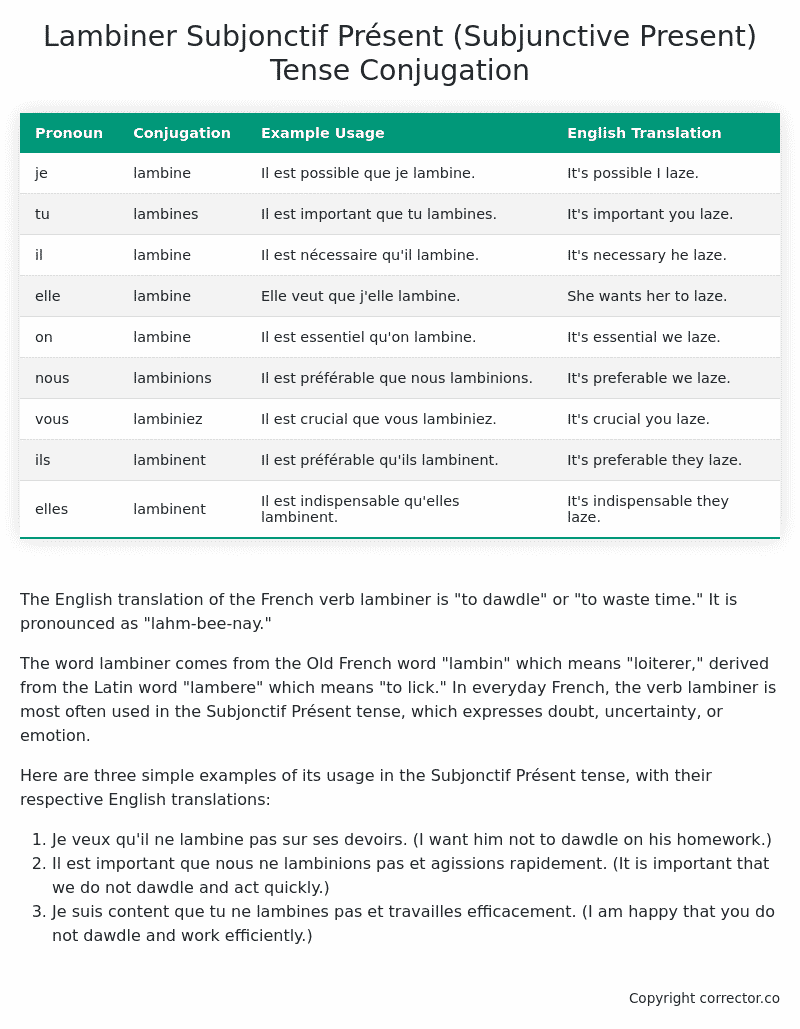Subjonctif Présent (Subjunctive Present) Tense Conjugation of the French Verb lambiner
Introduction to the verb lambiner
The English translation of the French verb lambiner is “to dawdle” or “to waste time.” It is pronounced as “lahm-bee-nay.”
The word lambiner comes from the Old French word “lambin” which means “loiterer,” derived from the Latin word “lambere” which means “to lick.” In everyday French, the verb lambiner is most often used in the Subjonctif Présent tense, which expresses doubt, uncertainty, or emotion.
Here are three simple examples of its usage in the Subjonctif Présent tense, with their respective English translations:
- Je veux qu’il ne lambine pas sur ses devoirs. (I want him not to dawdle on his homework.)
- Il est important que nous ne lambinions pas et agissions rapidement. (It is important that we do not dawdle and act quickly.)
- Je suis content que tu ne lambines pas et travailles efficacement. (I am happy that you do not dawdle and work efficiently.)
Table of the Subjonctif Présent (Subjunctive Present) Tense Conjugation of lambiner
| Pronoun | Conjugation | Example Usage | English Translation |
|---|---|---|---|
| je | lambine | Il est possible que je lambine. | It’s possible I laze. |
| tu | lambines | Il est important que tu lambines. | It’s important you laze. |
| il | lambine | Il est nécessaire qu’il lambine. | It’s necessary he laze. |
| elle | lambine | Elle veut que j’elle lambine. | She wants her to laze. |
| on | lambine | Il est essentiel qu’on lambine. | It’s essential we laze. |
| nous | lambinions | Il est préférable que nous lambinions. | It’s preferable we laze. |
| vous | lambiniez | Il est crucial que vous lambiniez. | It’s crucial you laze. |
| ils | lambinent | Il est préférable qu’ils lambinent. | It’s preferable they laze. |
| elles | lambinent | Il est indispensable qu’elles lambinent. | It’s indispensable they laze. |
Other Conjugations for Lambiner.
Le Present (Present Tense) Conjugation of the French Verb lambiner
Imparfait (Imperfect) Tense Conjugation of the French Verb lambiner
Passé Simple (Simple Past) Tense Conjugation of the French Verb lambiner
Passé Composé (Present Perfect) Tense Conjugation of the French Verb lambiner
Futur Simple (Simple Future) Tense Conjugation of the French Verb lambiner
Futur Proche (Near Future) Tense Conjugation of the French Verb lambiner
Plus-que-parfait (Pluperfect) Tense Conjugation of the French Verb lambiner
Passé Antérieur (Past Anterior) Tense Conjugation of the French Verb lambiner
Futur Antérieur (Future Anterior) Tense Conjugation of the French Verb lambiner
Subjonctif Présent (Subjunctive Present) Tense Conjugation of the French Verb lambiner (this article)
Subjonctif Passé (Subjunctive Past) Tense Conjugation of the French Verb lambiner
Subjonctif Imparfait (Subjunctive Imperfect) Tense Conjugation of the French Verb lambiner
Subjonctif Plus-que-parfait (Subjunctive Pluperfect) Tense Conjugation of the French Verb lambiner
Conditionnel Présent (Conditional Present) Tense Conjugation of the French Verb lambiner
Conditionnel Passé (Conditional Past) Tense Conjugation of the French Verb lambiner
L’impératif Présent (Imperative Present) Tense Conjugation of the French Verb lambiner
L’infinitif Présent (Infinitive Present) Tense Conjugation of the French Verb lambiner
Struggling with French verbs or the language in general? Why not use our free French Grammar Checker – no registration required!
Get a FREE Download Study Sheet of this Conjugation 🔥
Simply right click the image below, click “save image” and get your free reference for the lambiner Subjonctif Présent tense conjugation!

Lambiner – About the French Subjonctif Présent (Subjunctive Present) Tense
Formation of the Subjonctif Présent
Common Everyday Usage Patterns
Interactions with Other Tenses
Summary
I hope you enjoyed this article on the verb lambiner. Still in a learning mood? Check out another TOTALLY random French verb conjugation!


